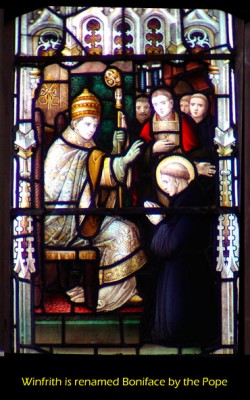Introduction
The Church of the Holy Cross and indeed the name of Crediton are both inextricably linked with St Boniface.
Boniface was born in Crediton in 680AD into a Saxon family. He was baptised Wynfrith or Winfrid (from the Saxon words wine – friend and frith – peace) . His first biographer, Willibald, writing in the C8th, records that he received his early education in a Benedictine monastery in Exeter. In his early teens he went from here to another monastery at Nursling (now a suburb of modern Southampton) in Hampshire, where, after many years of study and skilful teaching – he became head of the school and compiled the first ever dictionary of Latin grammar, he was ordained priest at the age of thirty.
Missionary
For many years he had felt called to missionary work and started this, at the age of thirty-six in Friesland – now part of Northern Holland, in 716. His first mission was unsuccessful, and he returned to Wessex where he was offered the job of Abbot of Nursling. He declined this, and went to Rome where, in May 719, Pope Gregory II commissioned him as a missionary to Germany. He was given the name Boniface, meaning maker of good or good deeds.
In accepting the commission, he undertook to use the Roman, rather than the Celtic Christian formula for baptism, and to consult the Vatican about any problems. His work took him to Hesse, Friesland and Bavaria.
Consecrated a Bishop
 Pictured left:Pope Gregory II gives Winfrith the name Boniface. (from the east window of Holy Cross).
Pictured left:Pope Gregory II gives Winfrith the name Boniface. (from the east window of Holy Cross).
In 722 he was consecrated a bishop – without a see. His remit was “to preach to the heathen east of the Rhine”. In 723 he visited the Frankish court and was taken under the protection of the king, Charles Martel (Martel meaning hammer). Over the next two years Boniface’s mission continued in Hesse and Thuringia where he established convents and started to create a disciplined system of churches. This was built on in the years which followed by the organisation of dioceses and provinces, all under the Pope, in other areas of Germany.
Felling of the Sacred Oak
A legend of this period is the best known of the whole of the saint’s life. On his arrival in Hesse, among half-believers with a lot of residual pagan beliefs and influences around them, Boniface struck at the root of pagan superstition by a single act. He publicly announced in advance that he would destroy their gods. Armed with an axe he approached a sacred tree, the giant oak of Geismar, dedicated to Thor. After some effort, he felled the oak, and its branches lay on the ground in the shape of a cross. In its descent, sections of the oak had crushed every other tree around except a single small fir tree (this was possibly the origin of the Christmas tree).

Boniface fells the Sacred Oak of Geismar (from the east window of Holy Cross).
Boniface made frequent pleas to the Christian Saxons of England to send supplies of both money and books, and of people – monks to help him in preaching and teaching – and sought and gave advice to many clerics in his home country in writing. Many of his letters of this time and later, still exist, and can be found, translated, on the Internet (go to the Internet Medieval Sourcebook on www.fordham.edu/halsall/sbook.html and type St Boniface into its search engine. A complete version of Willibald’s biography, translated into modern English, can also be found on the site.
Boniface in Germany
In 732 Boniface was consecrated archbishop – without a specific archiepiscopal see – by Pope Gregory III. He was authorised to organise the hierarchy of the church in Bavaria and created new four sees. He went on to found other sees at Erfurt, for Thuringia, Buraburg, for Hesse, and Wurzburg for Franconia. Later he established a see at Nordau in Eichstau.
Fulda
In 741 Boniface founded the abbey of Fulda with his young disciple, (Saint) Sturmi and in 745 he was given Mainz as his cathedral, being created Primate of all Germany by Pope Zachary. In the period 742-747, Boniface directed a series of reforming councils (much of their work dealt with abuses by new and inexperienced clergy) which were held in Francia.

The Martyrdom of Boniface, Dokkum, Netherlands, 754AD (from east window of Holy Cross).
In 753, Boniface set off for further missionary work in Friesland, and in 754 his life ended in martyrdom at the hands of a pagan band, who killed him as he was reading to a group of new converts on Pentecost Sunday. He would not allow his companions to defend him. His body was taken to Fulda, where it still rests.
Boniface Impact on History
Boniface has had an enormous impact on English and European history, far beyond the simple conversion of people to Christianity. His guidance of the early church in Germany, his establishment of structures which allowed it to co-exist with monarchy, were massively important, and the educational and literary influence from his monasteries and churches in his lifetime and over the next centuries was very significant. He is described as the Apostle of Germany and is greatly revered in Holland.
Boniface has been described by eminent historians as “The greatest Englishman of all time” and “the Englishman who has had a greater influence on the history of Europe than any other Englishman”, but in England he is not greatly known about.
Boniface Day
Boniface Day is celebrated on June 5th
 The key moments of Boniface’ life in stained glass in the East Window of Holy Cross.
The key moments of Boniface’ life in stained glass in the East Window of Holy Cross.
See Boniface in Images for more pictures of Saint Boniface.
For information about Fulda and St Boniface visit the Fulda Cathedral website


